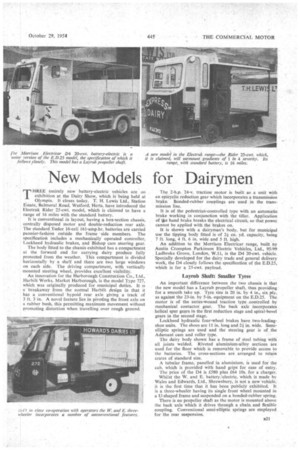New Models for Dairymen
Page 55

If you've noticed an error in this article please click here to report it so we can fix it.
THREE entirely new battery-electric vehicles are on exhibition at the Dairy Show, which is being held at Olympia. It closes today. T. H. Lewis Ltd., Station Estate, Balmoral Road, Watford, Herts, have introduced the Electruk Rider 25-cwt. model, which is claimed to have a range of 16 miles with the standard battery.
It is conventional in layout, having a box-section chassis, centrally disposed motor and double-reduction rear axle. The standard Tudor 16-cell 161-amp.hr. batteries are carried pannier-fashion .outside the frame side members. The specification includes a mechanically operated controller, Lockheed hydraulic brakes, and Bishop cam steering gear.
The body fitted to the chassis exhibited has a compartment at the forward end for carrying dairy produce fully protected from the weather. This compartment is divided horizontally by a shelf and there are two large windows on each side. The driving compartment, with vertically mounted steering wheel, provides excellent visibility.
An innovation for the Harborough Construction Co., Ltd., Harbilt Works. Market Flarborough, is the model Type 727, which was originally produced for municipal duties. It is a breakaway from the normal Harbilt design in that it has a conventional • hypoid rear axle giving a track of 3 ft. 3 in. A novel feature lies in pivoting the front axle on a rubber bush, this permitting maximum movement without promoting distortion when travelling over rough ground.
The 2-h.p. 24-v. traction motor is built as a unit with an epicyclic reduction gear which incorporates a transmission brake. Bonded-rubber couplings are used in the transmission line.
It is of the pedestrian-controlled type with an automatic brake working in conjunction with the tiller. Application of tate hand brake breaks the electrical circuit, so that power cannot be applied with the brakes on.
It is shown with a dairyman's body, but for municipal use the tipping body fitted is of 24cu. yd. capacity, being 7 ft. long, 4 ft. 6 in. wide and 5 ft. high.
An addition to the Morrison Electricar range, built by Austin Crompton Parkinson Electric Vehicles, Ltd., 95-99 Ladbroke Grove, London, W.11, is the D4 20-cwt. vehicle. Specially developed for the dairy trade and general delivery work, the D4 closely follows the specification of the E.D.25, which is for a 25-cwt. payload.
Layrub Shaft: Smaller Tyres
An important difference between the two chassis is that the new model has a Layrub propeller shaft, thus providing for a smooth take up. Tyre size is 20 in. by 4 in., six ply, as against the 23-in. by 5-in, equipment on the E.D.25. The motor is of the series-wound traction type controlled by mechanical contactor gear. The back axle incorporates helical spur gears in the first reduction stage and spiral-bevel gears in the second stage.
Lockheed hydraulic four-wheel brakes have two-leadingshoe units. The shoes are 11 in. long and 2-I in. wide. Semielliptic springs are used and the steering gear is of the Adamant cam and roller type.
The dairy body shown has a frame of steel tubing with all joints welded. Riveted aluminium-alloy sections are used for the floor which is removable to provide access to the batteries. The cross-sections are arranged to retain crates of standard size.
A tubular frame, panelled in aluminium, is used for the cab, which is provided with hand grips for ease of entry.
The price of the D4 is £580 plus £64 10s. for a charger.
Whilst the W. and E. battery/electric, which is made by Wales and Edwards, Ltd., Shrewsbury, is not a new vehicle, it is the first time that it has been publicly exhibited. It is a three-wheeler having its single front wheel mounted in a U-shaped frame and suspended on a bonded-rubber spring.
There is no propeller shaft as the motor is mounted above the back axle which it drives through a chain, and flexible coupling. Conventional semi-elliptic springs are employed for the rear suspension.




























































































